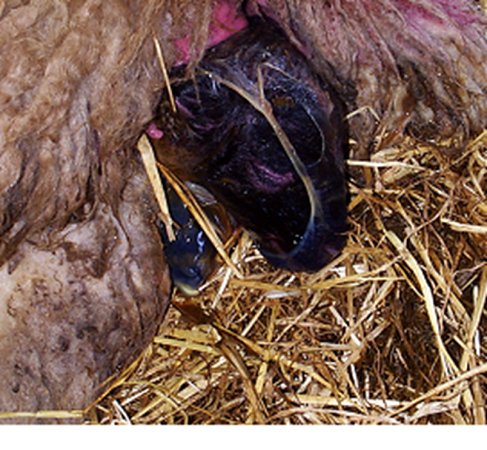

Ringwomb is also known as incomplete dilation of the cervix more than six hours after foetal membranes appear at the vulva. If the onset of first-stage labour was missed (in extensive outdoor lambing and calving systems) then it is difficult to correctly identify how much time has elapsed and whether the ewe or cow requires intervention.
There are a couple of signs to look for, it could be an animal in labour with nothing showing, there may or may not be a water bag showing and the ewe or cow may not be exhibiting classic signs of calving or lambing.
Frustratingly, that’s not really known. It could be an imbalance of hormones, which is quite likely as there is disruption in hormones when birthing. Another cause could be a stressful event in the few days before lambing or calving. There is also a suggestion that nutrition can be an influence, possibly a lack of calcium. Another cause could be if the animal had a bad lambing or calving previously, causing scar tissue in the cervix, which does not stretch like the normal tissue. If the dam has not come to full term, causing an abortion or stillborn foetus, this could also cause ringwomb, making the signs harder to see.
In humans, doctors can monitor the foetus to see if it is distressed but no such technology has been developed for lambs or calves yet, making the research on ringwomb more limited and decisions when to intervene difficult.
Because it is not known what causes ringwomb, it is hard to prevent it from happening. There are licensed drugs to help with ringwomb, but there is no real evidence to support their effectiveness. However, some might find them useful. If the ewe or cow has prolapsed or had difficulties in the past, then the risk is higher and it’s advised not to breed from them again.
Advice for delivering the lamb or calf when ringwomb occurs
First make sure that labour has been established. Examine the ewe or cow. Sometimes a prolapse (particularly in ewes) can be mistaken as straining to lamb. This needs different care, and, if in doubt, seek advice. Animals that prolapse are also more likely to have a ringwomb.
There should be space in the cervix, you should be able to get your fingers or hand in a ewe or your arm in a cow. The cervix shouldn’t be so tight that it is only open by a couple of centimetres. If this is the case, the animal is either in early labour and not ready to deliver or has a ringwomb.
The cervix should soften over time so time and care should be taken when examining the animal. Use a clean, gloved hand and plenty of lubrication. Try to dilate the cervix with gentle pressure but never force anything by pulling on the legs if there is not room or you could cause damage to the both the ewe/cow and the lamb/calf.
If the water bag is not broken and the cow or ewe is not distressed, you can leave the animal for an hour before checking again, but monitor her during this time. If the water bag has broken, do not leave it too long. The earlier you can get the lamb or calf out, the better chance it has and the quicker the recovery.
At this point you could give a dose of calcium, it’s not proven to solve ringwomb but is commonly used and unlikely to cause harm.
Leave for 30min, and if nothing has progressed, it could be time to involve a vet.
The vet will examine and then discuss the options, this could lead to a caesarean. The likelihood of a successful caesarean with live dam and offspring are higher with earlier intervention. Do not leave it until the ewe/cow is distressed and tired.
 Contact Jaguza Support
Contact Jaguza Support